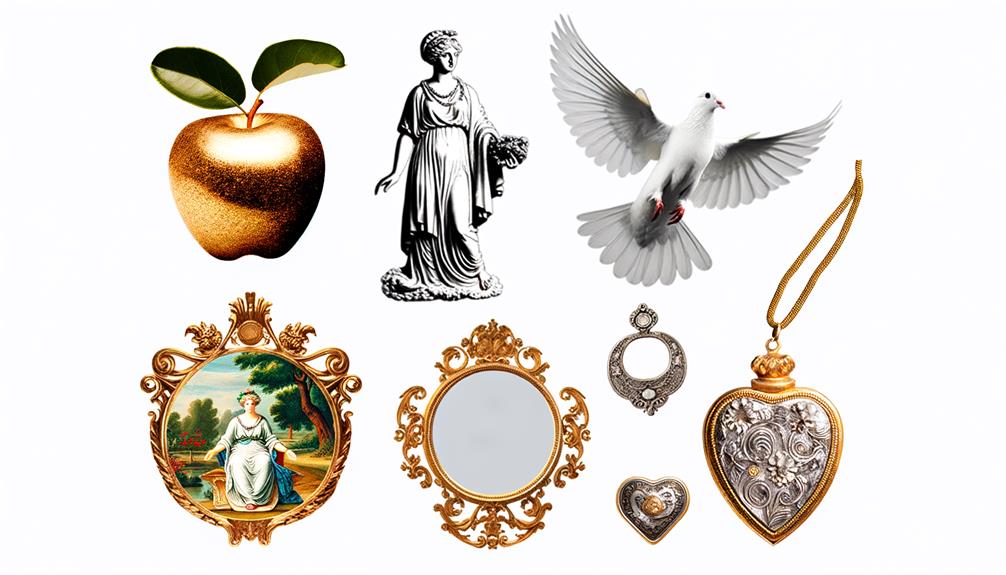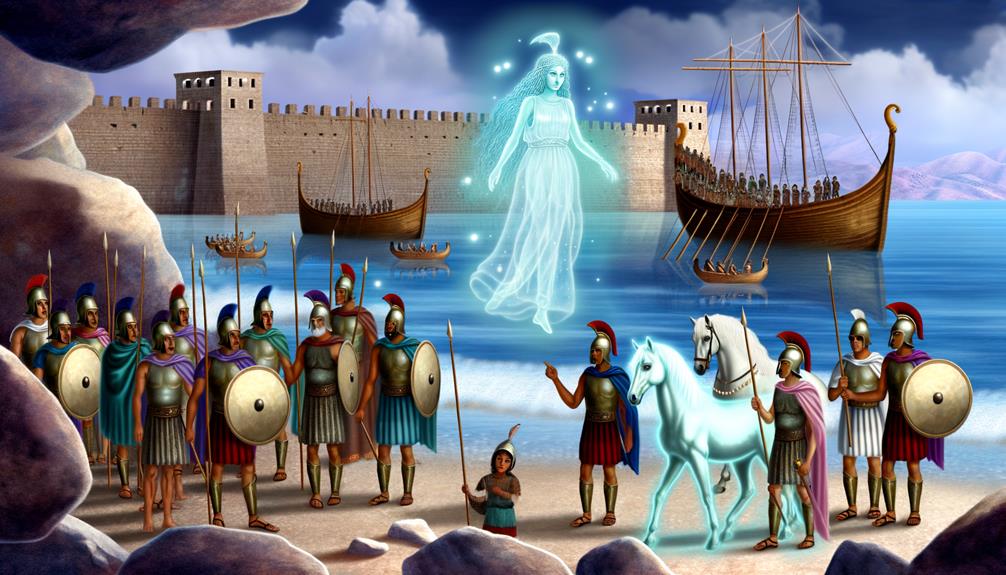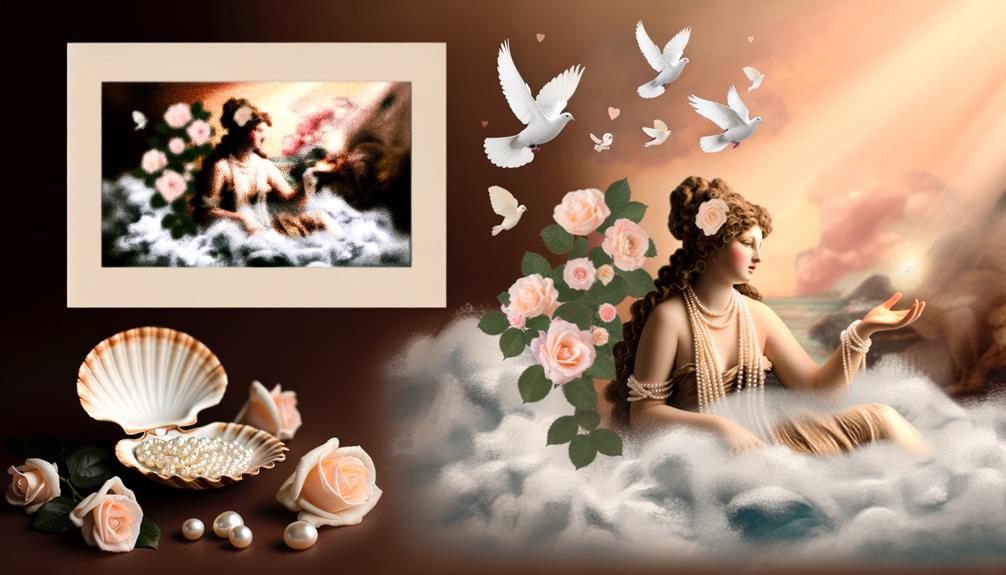Ever wondered how the ancient Greeks handled love? Well, they had a secret weapon – Aphrodite, the Goddess of Love. I've used a lot of my time to read through old texts and study artwork, putting together the puzzle that is Aphrodite's intricate story.
This goddess, born from sea foam after Cronus overpowered his father Uranus, represents the charm and strength of love. She's the unrivaled beauty among gods and humans alike. But it's not just about her looks. Her relationships, her part in the Trojan War, how she's portrayed in art – all these facets bring out her complex character.
As we delve into her story, you'll see she's more than just a beautiful face. So, are you up for understanding the depths of this compelling figure from Greek mythology?
The Birth of Aphrodite

Let's chat about the intriguing birth story of Aphrodite, the Greek goddess of love, beauty, and fertility. According to ancient Greek mythology, she came into existence from the froth produced by Uranus' severed private parts. Her unusual birth story, rich with symbolism and cosmic might, highlights Aphrodite's distinctive role in mythological narratives.
The number 86, which may seem arbitrary, holds a special place in Aphrodite's story. This was the count of her rumored lovers, encompassing both gods like Ares and mortals such as the shepherd Anchises, echoing her divine role as a love goddess. She was so beautiful that the artist Praxiteles created a full-scale nude statue of her, marking a change in the way she was represented in art.
Aphrodite's birth from sea foam strengthened her ties to femininity, eroticism, and fertility. The fact that she was born from the sea, without a mother, sets her apart from the conventional patriarchal lineage traced back to Zeus. This autonomy, along with her extensive sway over love and beauty, positioned Aphrodite as a key character in Greek mythology.
Looking more closely at her story, we find that Aphrodite was more than a goddess; she represented the innate strength of womanhood.
Aphrodite's Significant Relationships

Have you ever delved into Aphrodite's complex love life? Let me tell you, she was far from sitting on the sidelines. In fact, her actions often had a major impact, shaking up the lives of both gods and mortals.
Take her marriage to Hephaestus, Olympus' master craftsman. Despite their union, she didn't limit her affections to him alone. She also found herself drawn to Ares, the god of war. Their secret love affair was eventually exposed for all to see, causing quite the stir in the divine realm.
Aphrodite had quite a few mortal lovers, too. Take Anchises, for instance, a humble shepherd. He was charmed by Aphrodite Urania, the heavenly version of her. The result of their love? A son named Aeneas who'd go on to become a hero of Troy. Then there was Adonis, a mortal renowned for his good looks. Their romance was both fiery and tragic, and it's remembered to this day in an annual event marked by both sorrow and rejoicing.
Of course, we can't overlook her son Eros, the god of love himself. Aphrodite once asked him to make Psyche, a mortal woman, fall for the most hideous creature imaginable. But in a twist of fate, Eros ended up falling for Psyche himself. That's one love story that's had a lasting impact, demonstrating the trials and tribulations of love and sacrifice.
The Role of Aphrodite in Trojan War

Let's chat about the Trojan War. One figure stands out: Aphrodite. Also known as Venus in Roman tales, Aphrodite is the goddess of love and beauty. The story goes that she promised Paris, a simple Trojan shepherd, the world's most beautiful woman if he'd proclaim her the fairest of the goddesses.
Aphrodite wasn't just a doting mother to Aeneas, a heroic Trojan. She also had Paris's back throughout this age-old conflict. Aphrodite's promise tempted Paris into running off with Helen, which ignited the Trojan War. The Greek and Roman gods took sides, and Aphrodite shook things up by stirring desire and love to sway the outcome on the battlefield.
When the war ended, Aphrodite's influence was still felt. After all, her promise to Paris was the root cause of the conflict.
Depictions of Aphrodite in Art

Let's chat about the influence of Aphrodite in the world of art. This Greek goddess of beauty has left a lasting imprint on how we perceive feminine beauty in classical art.
The way artists have chosen to portray Aphrodite has changed quite a bit over time. At first, painters and sculptors from ancient Greece depicted Aphrodite fully clothed. However, a marble statue by a sculptor named Praxiteles made waves in the art world. This statue was unique because it was the first full-scale female nude. This change in approach had a huge impact on future representations of Aphrodite, including the legendary Venus de Milo that you can find in the Museum of Fine Arts.
After that, the ways Aphrodite was represented in art took a turn. The goddess was depicted with various degrees of clothing and body types, giving us a vibrant and changing image of what female beauty can look like. Aphrodite's influence was felt in public statues, private garden sculptures, and even small keepsakes.
This flexible representation of Aphrodite not only shows how the idea of beauty changed in ancient times but also demonstrates how the allure of this goddess of beauty is still felt when we talk about classical art today.
Aphrodite's Influence in Modern Culture

Let's chat about how the goddess Aphrodite continues to make her mark on contemporary culture. Her essence is interwoven into various artistic expressions, literature, and pop culture, highlighting our ongoing fascination with this deity symbolizing love and beauty. As Zeus's daughter, her legend has been interpreted in myriad ways, from ancient Roman poets to modern-day writers.
Let's touch on a few key areas where Aphrodite's influence shines:
- Venus, the Roman equivalent of Aphrodite, frequently appears in art, embodying love and beauty. Notable pieces like Botticelli's 'Birth of Venus' and the 'Venus de Milo' sculpture are prime examples.
- Modern literature and media often use her love affair with Adonis as a source of romantic inspiration.
- The concept of Aphrodite Pandemos, symbolizing universal love, resonates with our current society's focus on inclusivity.
- Her sons, Eros and Himeros, who personify desire and lust, are common references in discourses on love and passion.
Aphrodite, said to have emerged from the sea foam near Cyprus's islands, continues to captivate us. Her ancient stories still inform our contemporary views on love and beauty.
Frequently Asked Questions
Is Aphrodite the Goddess of Love?
Absolutely, Aphrodite is certainly recognized as the goddess of love. This iconic figure from Greek mythology is not only linked with love but also with beauty and desire. She symbolizes the irresistible charm and intensity of love that was revered in the times of ancient Greece and Rome.
Who Is Comparable to Aphrodite the Goddess of Love?
Wondering about other figures who might be similar to a certain goddess of love? Let's talk about Venus, Ishtar, Astarte, Hathor, Freyja, Parvati, and Brigid. These figures, each from their own unique mythos, have a lot in common with her. They all represent ideas of love, beauty, and fertility. So, in a way, they can be seen as her counterparts in their respective traditions. It's quite fascinating how these themes are universal in human storytelling, isn't it?
What Is Aphrodite's Power?
So, you're curious about Aphrodite and her powers? Well, let's chat about it. This goddess from mythology is all about the heart – love, desire, and beauty are her main domains. But there's more to her than just that. She's also connected with fertility and, on occasion, even marriage. And you know what's cool? You can see her charm and influence woven into many traditional Greek and Roman works of art. Pretty neat, huh?
What Is Aphrodite Symbol?
Aphrodite, a prominent figure in ancient myths, is associated with a variety of symbols such as seashells, myrtles, roses, doves, sparrows, and swans. These symbols aren't just random; they actually reflect different aspects of her character. She was seen as a goddess who held sway over love, beauty, and fertility, and these symbols were a way of representing these aspects of her persona. It's fascinating how these symbols were selected and how they continue to connect us with her story even today.
Conclusion
Aphrodite's story isn't just ancient history – it still has meaning for us today. You might wonder why bother with a deity from so long ago. But this isn't just about Aphrodite.
It's about what she represents: the power of love and beauty. These things have an ageless appeal and they can create harmony or conflict.
Aphrodite helps us examine our own needs, worries, and inner conflicts. She's more than just a character from Greek mythology. She's a way for us to connect with the timeless aspects of human experience.
